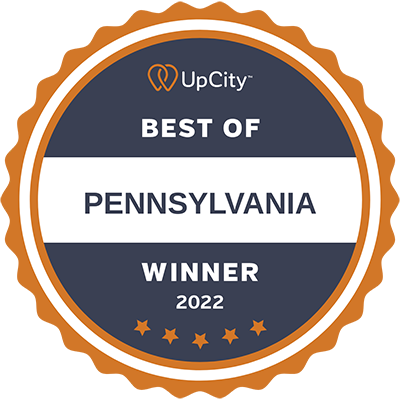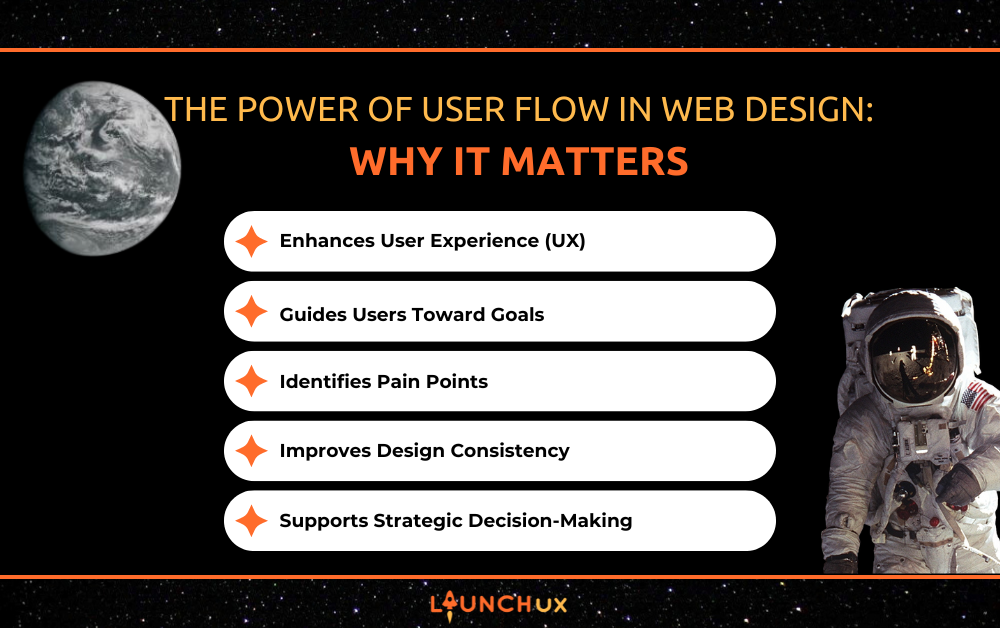At LaunchUX, great websites are built with the user in mind. Whether you’re operating an e-commerce store, running a service-based business, or sharing content through a blog, optimizing user flow is essential. It’s not just about aesthetics—it’s about how users move through your site to accomplish their goals. A well-planned user flow keeps visitors engaged and reduces frustration. Ultimately, this method enhances the user experience and drives better conversion rates. Understanding and designing for user flow can transform a decent website into an exceptional one.
Enhances User Experience (UX)
Creating Intuitive Navigation Paths
Designing intuitive navigation means structuring your website so users can find what they need without overthinking. When users can easily figure out where to click or scroll next, they feel in control of their experience. A solid user flow provides that guidance naturally, eliminating guesswork. Users don’t want to be challenged when browsing—they want clarity. Streamlined navigation keeps users on track and reduces the likelihood of abandonment. Over time, this ease of use builds loyalty and repeat visits.
Reducing Confusion and Frustration
Poor navigation and unclear structure can quickly drive users away. If visitors can’t find what they’re looking for, they may leave your site entirely, often without returning. A good user flow prevents this by ensuring every element serves a clear purpose and leads users forward. With fewer dead ends and distractions, users feel less overwhelmed. This level of clarity creates a smoother and more rewarding experience. A frustration-free environment helps build trust and keeps users coming back.
Encouraging Positive Interactions
If users find a site simple to navigate, they are more inclined to engage with it. This could mean reading more content, signing up for a newsletter, or making a purchase. These interactions are driven by how well the user flow is crafted. If every page and link contributes to a coherent journey, users will naturally take action. Their satisfaction comes from the feeling that everything works as expected. A positive experience often leads to brand loyalty and recommendations.
Guides Users Toward Goals
Aligning Flow with User Intent
Every visitor comes to a website with a goal in mind. Whether it’s to learn, buy, sign up, or contact you, your site should support that intent from the first click. A strong user flow identifies these goals and builds pathways that make them easy to achieve. This alignment means fewer obstacles and more completed actions. Instead of guessing, users feel like the site was made just for them. As a result, your conversion rates improve naturally.
Simplifying the Conversion Journey
The fewer steps it takes to complete a goal, the better the experience. A user flow that removes unnecessary elements keeps users focused and moving forward. Clear calls to action and logical page transitions reduce hesitation. When users don’t have to work hard to convert, they’re more likely to follow through. Every part of the journey should feel purposeful and streamlined. Simplicity often leads to more completed signups, sales, and contacts.
Leading Users to Key Actions
Your website should gently guide users toward necessary actions without being pushy. Whether it’s purchasing a product or filling out a form, these moments should feel natural within the user flow. Strategic placement of buttons and content plays a huge role here. If users feel confident and informed at the right time, they’re more likely to take action. Flow-driven design ensures that these touchpoints are precisely where they need to be. The result is a site that not only looks good but performs effectively.
Identifies Pain Points
Understanding User Behavior
Studying your user flow gives valuable insight into how visitors interact with your site. You can see where they enter, how long they stay, and where they go next. This behavior reveals what works well and what might be confusing. With this analysis, you’re equipped to make smarter, data-driven decisions that improve the experience. Instead of guessing, you’re responding to real usage patterns. This level of understanding is key to continuous improvement.
Spotting Drop-Off Zones
Drop-off points are parts of your site where users tend to leave. These could be due to slow-loading pages, unclear messaging, or poor layout. A precise user flow can highlight these trouble spots so you can fix them. Once identified, small changes can lead to significant improvements in engagement. Reducing friction keeps users on the site longer and increases conversions. Proactively addressing these issues helps maintain a positive user experience.
Improving Overall Site Usability
User flow analysis isn’t just for fixing problems—it also highlights opportunities for growth. You may find pages that perform well and use that success to improve other areas. This leads to a more cohesive and usable site. When users feel comfortable and confident, they’re more likely to stay, explore, and convert. Consistent usability across all pages builds trust with your audience. The more usable your site is, the stronger your brand becomes.
Improves Design Consistency
Creating a Logical Structure
Designing with user flow in mind forces you to think about how each page connects to the next. This creates a logical and seamless structure throughout your website. Users appreciate it when they don’t have to figure things out on their own. Instead, the site’s layout guides them from one section to the next without surprises. This consistency improves the overall flow and helps users stay focused. A logical structure also enhances accessibility for all types of visitors.
Enhancing Visual and Functional Harmony
User flow isn’t just about navigation—it influences the look and feel of your site too. A flow-focused design ensures that buttons, menus, and visuals are placed where users expect them. This creates a sense of harmony that makes the site more enjoyable to use. Functional consistency builds user confidence in your platform. When users know what to expect, they’re more likely to explore freely. This balance between design and usability leads to better outcomes.
Building Trust Through Predictability
Consistency across pages fosters predictability, which is key to user trust. When design elements and layout patterns repeat in a purposeful way, users feel more at ease. They learn how your site works quickly and are less likely to get confused. Predictability doesn’t mean boring—it means reliable and user-friendly. A predictable user flow reassures users that they’re in the right place.
Supports Strategic Decision-Making
Informing Content Placement
Knowing how users move through your site helps determine where content should live. You can prioritize high-impact areas and remove or reposition underperforming elements. Content placement based on user flow improves readability and engagement. Visitors will see that well-timed communication significantly improves conversion outcomes. This strategic approach saves time and maximizes return on content. Clever placement is one of the most powerful outcomes of analyzing user flow.
Enabling Smarter Marketing Choices
Marketing efforts are far more effective when they’re informed by user behavior. When you understand the user flow, you can craft campaigns that match how visitors engage with your site. You’ll know which pages drive the most value and can invest accordingly. From landing pages to email funnels, user flow shapes every touchpoint. The result is a more aligned and effective marketing strategy. Knowing your users leads to better messaging and better ROI.
Aligning Teams on Goals
User flow clarity benefits more than just designers—it unites the entire team. Marketers, developers, and project managers can all rally around a collective insight into the user’s path through the website. This alignment leads to better communication and faster decision-making. Everyone knows what the goals are and how to achieve them through design and strategy. Collaboration improves because each team member sees how their role supports the user. A shared focus on flow leads to stronger, more cohesive results.
Building Better Websites with LaunchUX
At LaunchUX, we know that success starts with understanding your audience. That’s why we prioritize user flow in every web design project. A strong user flow improves experience, increases engagement, and helps turn visitors into loyal customers. It’s not just a design tactic—it’s a strategic tool for building high-performing websites. When your site works seamlessly, your brand stands out in a crowded digital space. If you’re ready to elevate your website’s performance, LaunchUX is here to guide the way.
Let’s map out your user flow and build a site that delivers—contact LaunchUX today.





